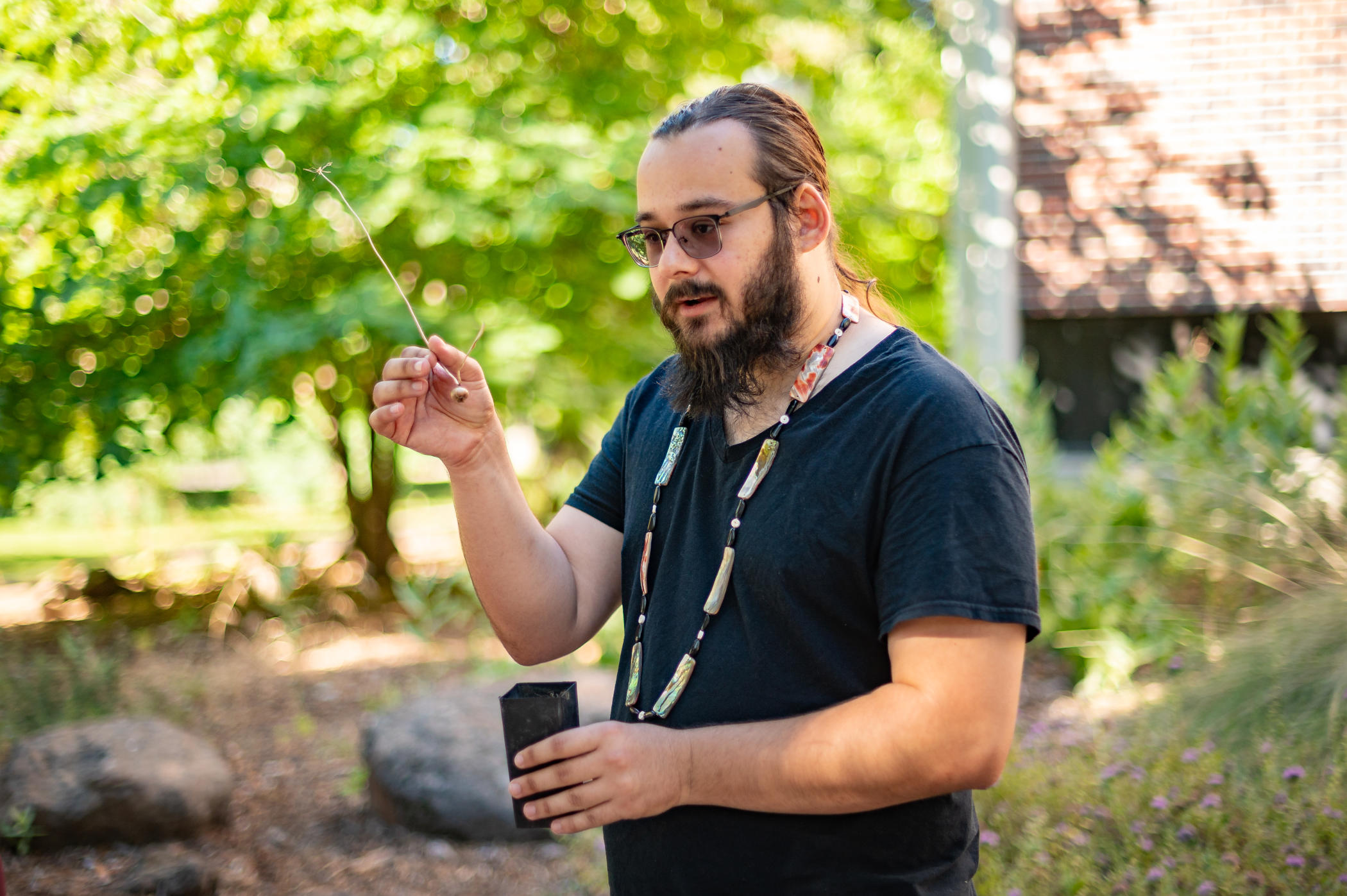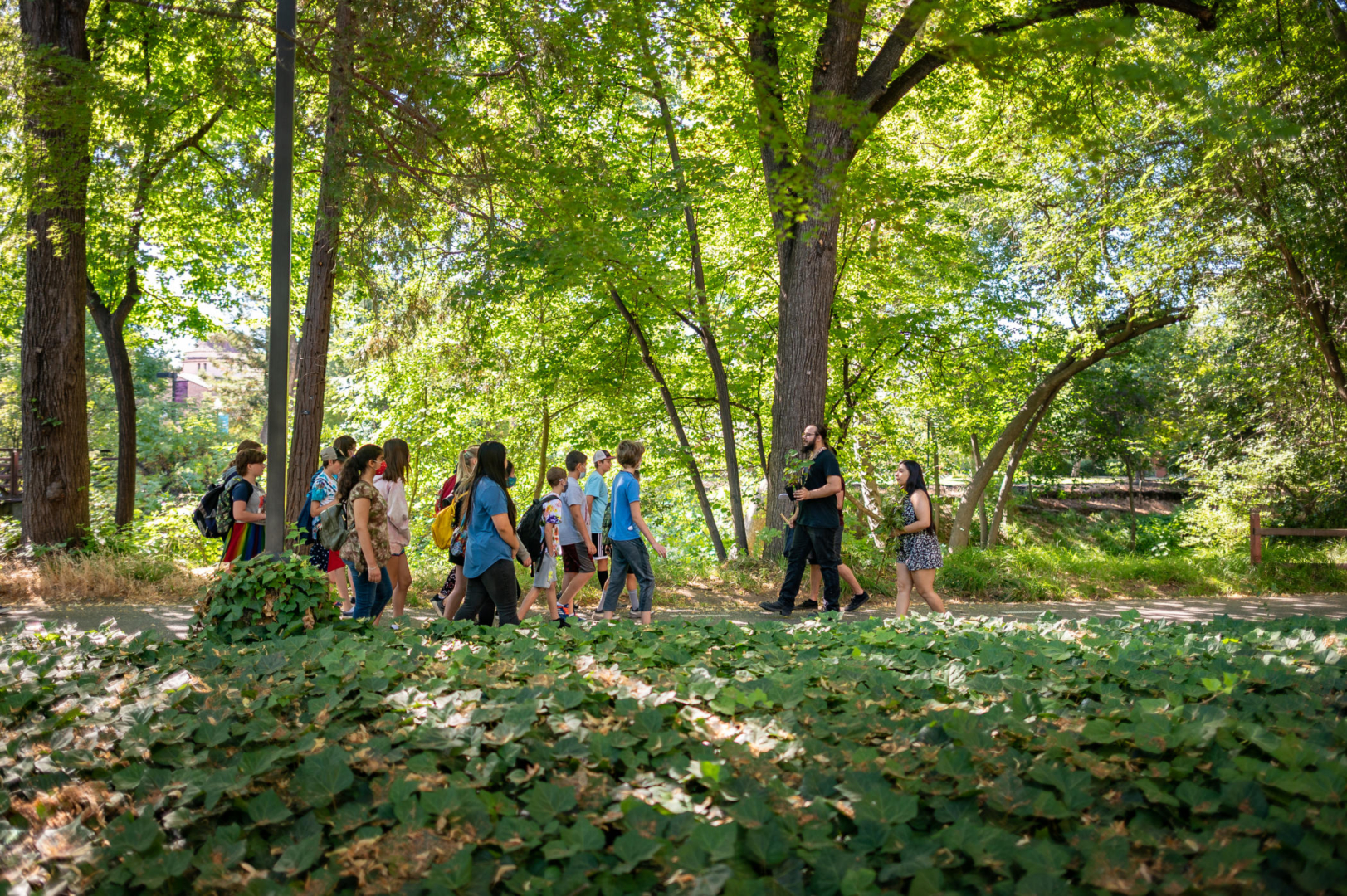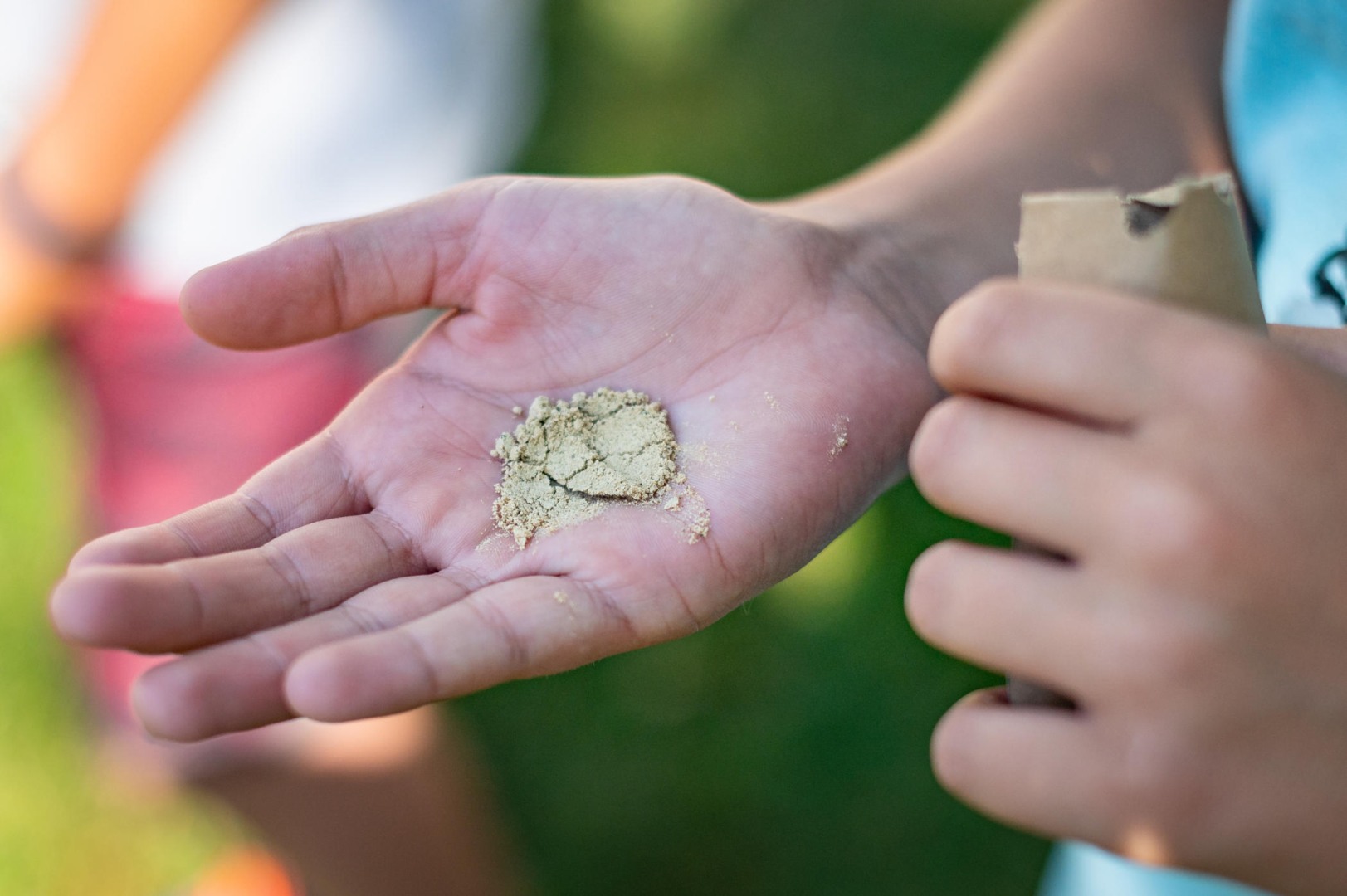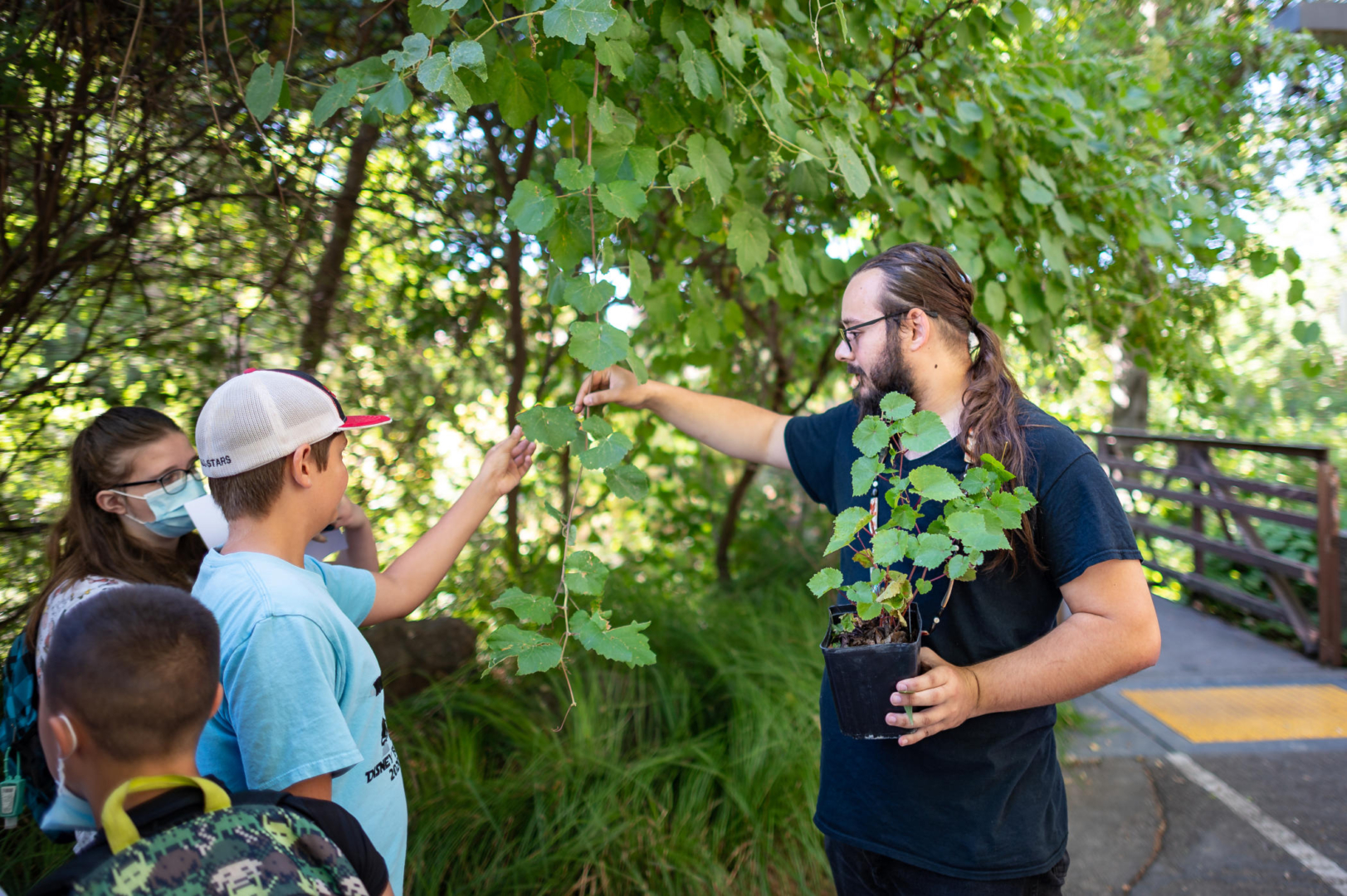Inaugural Climate Fellows Share Traditional Ecological Knowledge

He-Lo Ramirez shares about TEK (Traditional Ecological Knowledge) with Jr. High School students around campus on Wednesday, June 23, 2021 in Chico, Calif. TEK Certification prepares a large-scale, ecologically trained workforce to restore abundant and resilient native ecosystems – supporting communities by encouraging locally based livelihoods while mitigating the effects of climate change. (Jason Halley/University Photographer/CSU, Chico)
When He-Lo Ramirez was a young boy, he spent summers with his father living off the land in the Feather River Canyon and surrounding mountains. They would catch rainbow trout from icy streams, pick plump wild grapes from the vines, and dig in soft soils to uncover wild onions—subsisting as their ancestors had since the start of time.
As he remembers the thrill of it all, he hopes to share that joy with a new generation of children—and in doing so, inspire in them a passion for eating wild plants and conserving the natural world.
“The land itself just needs to be taken care of, and it will take care of you in return,” said He-Lo, who is Mechoopda.
This summer, he is promoting conservation concepts as one of nine Chico State fellows in the California Climate Action Corps, a new pilot AmeriCorps program supported locally by campus and community partners and University Advancement. With a bold mission and a service-minded corps of about 230 fellows, it strives to empower Californians to safeguard the climate, reduce impacts to the environment, and protect community health.
He-Lo developed the idea for a fellowship based on Traditional Ecological Knowledge (TEK). Its premise is to educate the general public—especially youth—on food sovereignty, native plants and their uses, and the critical need for pollinators and supporting habitat, building upon volunteer work He-Lo has done at Chico State for years
After earning his bachelor’s degree in biological sciences in 2019, He-Lo completed his teaching credential and enrolled in the first cohort for the master’s degree in wildland management. He continues working in the Office of Tribal Relations, where he helped create a Native Cultural Tour and is helping establish a traditional gathering program on campus. He also works as a cultural steward and wildland firefighter at the University’s Big Chico Creek Ecological Reserve, blending his rich personal knowledge and education with his passion for conservation.

On a recent weekday, He-Lo and another TEK fellow, sophomore Frankie Torres, welcomed two dozen Bidwell Junior High students to campus for a cultural and ecological tour along the banks of Big Chico Creek.
“Niki já sum He-Lo. My name is He-Lo,” He-Lo told the children. “Hétynàjem. That means ‘greetings’ or ‘hello, ya’ll.’”
He started with a brief history of City of Chico founder John Bidwell, their school’s namesake, and explained how he employed the Mechoopda on his land after they were removed from their indigenous lands on the Big Chico Creek and Butte Creek watersheds. Within the context of the legal slave trade of California Indians at that time, Bidwell offered protection and paid fair wages, but also stripped the Mechoopda of their culture and vital connection to the natural world, He-Lo said. The students listened quietly as he told them the Mechoopda village was where Holt Hall stands today.
The Mechoopda origin story begins with the creation of the world here in Chico, He-Lo said, adding that the area was once rich with wildlife like elk, bears, and antelope and covered with native plants, including the ló:wi (valley oaks) towering above the students’ heads, which sustained the Mechoopda for centuries. As he explained the laborious process of turning acorns into flour, Torres passed out acorns in an abalone shell and samples of bát’i (acorn flour) for the children to touch.
“It’s so soft,” said one girl, gently touching the powder in her palm.
Growing up in the rural forests of Clipper Mills, Torres never really connected his Paiute identity to his diet. As the other TEK fellow, he said he’s been fascinated as he learns the rich history of the plants that have surrounded him for so long, their inherent value hidden in plain sight.
“It’s great working with He-Lo, because he is pretty much an expert,” said Torres, a criminal justice major. “Learning all this and being able to appreciate the natural life is awesome.”

As the students listened, spellbound, He-Lo told stories about using múnmuni (mugwort) and bay leaves as an insect deterrent to protect their harvest, weaving baskets from lýli (Western redbud), catching salmon in Big Chico Creek, and using fire as a conservation tool. He compared the acorn flour to what the children would use for baking at home and the pímmili (California wild grapes) to those in the grocery store—the same color, but smaller and with a lot of seeds.
“Part of learning is that cool factor, being able to identify plants, but I also want them to see value—‘I have a connection to this so now I care about it,’” he said.
As the He-Lo and Torres led their tour, the junior high school students rubbed plants between their fingers and inhaled deeply, plucked young green grapes off the vines, and peppered their guides with questions about other uses for the plants, catching grasshoppers, and what acorn stew is like.
“I’m a proponent of place-based learning and hands-on learning,” He-Lo said. “People learn better when they touch things and you talk about them. I want to make it fun, engaging, and applicable.”
He capped the tour by passing out small packets of native California wildflowers and told the children to plant them in the fall. When the yarrow, red monkey flower, and California poppies grow, they will support insects and other life that depend on them.
“If we get enough people to plant these in Chico, native pollinators can jump from neighborhood to neighborhood,” he said.
Later this summer, Mechoopda Tribal youth will take a similar tour, as will students from Four Winds of Indian Education.
Meanwhile, other Climate Action fellows are working with the University’s director of energy and sustainability; an interdivisional partnership for first-term students; the Butte Environmental Council; and the Paradise Recreation and Park District. Alternative transit and trails efforts, climate education conferences and workshops, and events and activities for community members and students will advance climate action and climate education into the start of the fall term.

For 10 weeks, the fellowship students will dedicate 250 hours to on-the-ground climate action and climate education, and spend another 50 hours in mentoring and professional development. In exchange, they earn a $4,000 living allowance and $1,300 educational award to put toward their college expenses.
“Our students have the heart for this work but they typically have to earn money in the summer to return to campus,” said Emilyn Sheffield, fellowship program director. “The California Climate Action Corps provides a way for students to refine and apply their leadership skills, receive financial support for educational expenses, and help our service area.”
Sheffield said the University’s network of campus and community partners and University Advancement have been essential to create these opportunities for our students and recent graduates.
“And the Fellows, in turn, will create opportunities for others to contribute to positive climate activities now and into the future,” she said.


